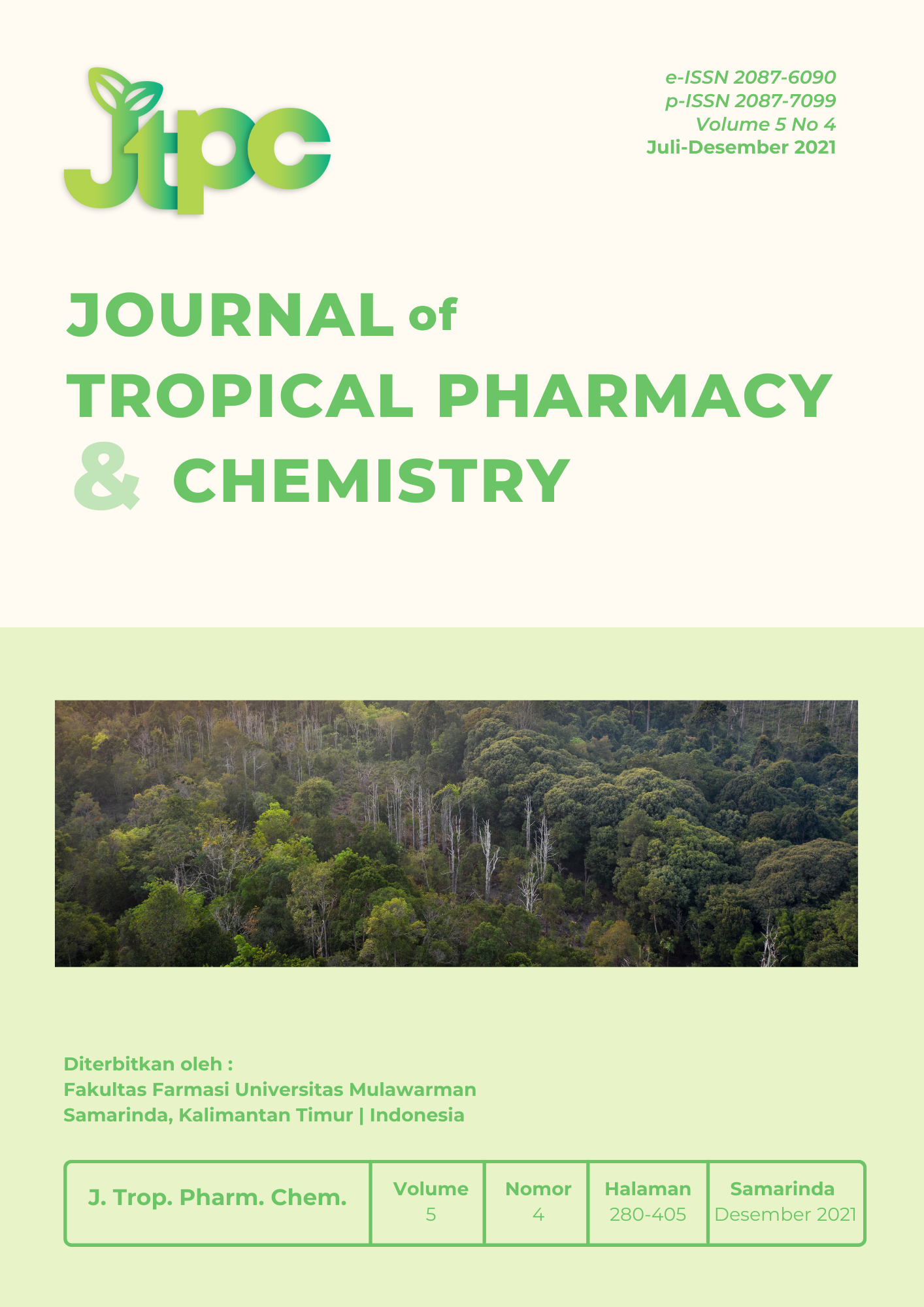Analysis of Flavonids and Terpenoids in Ethanol Extract of Colocasia esculenta L. (Schoot) Stalk and Leaves
DOI:
https://doi.org/10.30872/j.trop.pharm.chem.v5i4.259Keywords:
Colocasiaesculenta, Stalk, Leaves, Flavonoids, TerpenoidsAbstract
Colocasia esculenta L. (Schoot) is a widely used plant in developing countries in Asia, Africa, and Central America. The parts of the Colocasia plant that can be used are the tubers, stalks, and leaves. There has not been much research on the content of this plant. The study aims to determine the flavonoids and terpenoids in the ethanol extract of Colocasia stalk and leaves. The maceration method with 70% ethanol solvent and drying with vacuum evaporator. Determination of flavonoid levels based on quercetin marker compounds using AlCl3 reagent by UV-Vis spectrophotometry. The terpenoid levels were carried out gravimetrically with petroleum ether as a solvent. The results showed that the ethanol extract of Colocasia stalk and leaf contained flavonoids, respectively 3.18 +0.0581% and 4.33 +0.0285%, while the results of the terpenoid levels for stalks were 7.10 +0.0676% and leaves were 8.39 +0.0023%.
Downloads
References
[1] Prajapati R, Kalariya M, Umbarkar R, Parmar S, Sheth N, 2011. Colocasia esculenta?: A potent indigenous plant, International Journal of Nutrition, Pharmacology, Neurological Diseases, 1,(2), 90–96.
[2] Herwin, Baits M, 2016. Aktivitas antibakteri ekstrak etanol daun talas ketan (Colocasia esculenta) terhadap bakteri Saphylococcus aureus dan Salmonella thypi secara difusi agar, As-Syifaa Jurnal Farmasi, 8,(1), 69–75.
[3] Wijaya BA, Citraningtyas G, Wehantouw F, 2014. Potensi ekstrak etanol tangkai daun talas (Colocasia esculenta L.) sebagai alternatif obat luka pada kulit kelinci (Oryctolagus Cuniculus), Pharmacon: Jurnal Ilmiah Farmasi, 3,(3), 211–219.
[4] Fadlila WN, Yuliawati KM, Syafnir L, 2015. Identifikasi senyawa aktif antibakteri dengan metode bioautografi klt terhadap ekstrak etanol tangkai daun talas (Colocasia esculenta (L.) Schoot), Prosiding Penelitian Spesia Unisba, 14 Agustus 2015, 583–590.
[5] Dalimartha S. 2006. Atlas Tumbuhan Obat Indonesia Jilid 4. Jakarta (ID): Puspa swara.
[6] Hibai ARY, Herwin, Kosman R, 2015. Antibacterial activity assay of ethanolic extract of bulbs sticky Colocasia (Colocasia esculenta) use TLC-bioautografi, Journal of Chemical Information and Modeling, 7,(1), 76–84.
[7] Biren NS, Nayak BS, Bhatt SP, Jalalpure S, Seth AK, 2007. The anti-inflamatory activity of the leaves of Colocasia esculenta, Journal Saudi Pharmaceutical, 3,(15), 3–4.
[8] Eddy NO, 2009. Inhibitive and absorption properties of etanol extract of Colocasia esculenta Leaves for corrosion of mild steel in H2SO4, International Journal of Physical Sciences, 4,(4), 165–171.
[9] Setyowati M, Hanarida I, 2007. Karakteristik umbi plasma nutfah tanaman talas (Colocasia esculenta), Jurnal Buletin Plasma Nutfah, 13,(2), 49–55.
[10] Atmaja ND, 2007. Aktivitas Antioksidan Fraksi Eter dan Air Ekstrak Metanolik Daun Jambu Biji Terhadap Radikal Bebas 1,1-difenil 2-pikrilhidrazil (DPPH), [Skripsi], Surakarta (ID): Fakultas Farmasi, Universitas Muahamadiyah Surakarta.
[11] Anggraini W, 2008. Efek Antiinflamasi Ekstrak etanol Daun Jambu Biji (Psidium guajava Linn.) Pada Tikus Putih Jantan Galur Wistar, [Skripsi], Surakarta (ID): Fakultas Farmasi, Universitas Muhamadiyah Surakarta.
[12] Saroja M, Santhi R, Annaporani S, 2012. Wound healing activity of flavonoid fraction of cynodon dactylon in swiss albino mice, International Research Journal of Pharmacy, 3,(2), 230–231.
[13] DepKes RI. 2008. Farmakope Herbal Indonesia, edisi 1. Jakarta (ID): Departemen Kesehatan Republik Indonesia.
[14] Hanani E. 2015. Analisis Fitokimia. Jakarta (ID): EGC.
[15] Dwisari F, Harlia, Alimudin AH, 2016. Isolasi dan karakteristik senyawa terpenoid ekstrak metanol akar pohon kayu buta – buta (Excoecaria agallocha L.), Jurnal Kimia Khatulistiwa, 5,(3), 25–30.
[16] Aminah, Tomayahu N, Abidin Z, 2017. Penetapan kadar flavonoid total ekstrak etanol kulit buah alpukat (Persea americana Mill.) dengan metode spektrofotometri UV-Vis, Jurnal Fitofarmaka Indonesia, 4,(2), 226–230.
[17] Malik SK, Ahmad M, Khan F, 2017. Qualitative and quantitative estimation of terpenoid contents in some important plants of Punjab, Pakistan, Pakistan Journal of Science, 69,(2), 150–154
[18] DepKes RI. 2013. Farmakope Herbal. Jakarta(ID): Departemen Kesehatan Republik Indonesia.
[19] Prayoga EGD, Nocianitri AK, Puspawati NN, 2019. Identifikasi senyawa fitokimia dan aktivitas antioksidan ekstrak kasar daun pepe (Gymnema reticulatum Br.) pada berbagai jenis pelarut, Jurnal Ilmu Dan Teknologi Pangan, 8,(2), 111–121.
[20] Winahyu DA, Retnaningsih A, Aprillia M, 2019. Penetapan kadar flavonoid pada kulit batang kayu baru (Cotylelobium melanocylon P) dengan metode spektrofotometri UV-Vis, Jurnal Analisis Farmasi, 4,(1), 29–36.
[21] Azizah DN, Faramayuda F, 2014. Penetapan kadar flavonoid metode AlCl3 pada ekstrak metanol kulit buah kakao (Theobroma cacao L.), Kartika Jurnal Ilmiah Farmasi, 2,(2),45–49.
[22] Dirjen POM. 2004. Farmakope Indonesia Edisi IV. Jakarta (ID): Departemen Kesehatan Republik Indonesia.
[23] Lindawati YN, dan Solikhah, 2018. Determination of total flavonoid levels on leaf stalks ethanol extract of taro, Proceedings International Conference on Helathcare, 1 September 2018, Sekolah Tinggi Ilmu Kesehatan Nasional, Surakarta, Indonesia.
[24] Setharaksa S, Jongjareonrak P, Hmadhlu W, Chansuwan, and Siripongvutikorn S, 2012. Flavonoid, phenolics contents and antioxidant properties of thai hot curry paste extract and its ingredients as affected og ph, solvent types, and high temperatures, International Food Research Journal, 19,(4), 1581 – 1587.
[25] Safrina D, dan Priyambodo JW, 2018. Pengaruh ketinggian tempat tumbuh dan pengeringan terhadap flavonoid total sambang colok (Iresine Herbstii). Jurnal Penelitian Pascapanen Pertanian, 15,(3), 147 – 154.
[26] Rosyid AL, Fachriyah E, Kusrini D, 2016. Isolasi, identifikasi dan uji aktivitas senyawa triterpenoid rimpang bengle (Zingiber cassumunar Roxb.) sebagai antibakteri, Jurnal Kimia Sains Dan Aplikasi, 19,(1), 1–6.
[27] Singh V, Pandey VN, dan Shukla K, 2015. Quantitative estimation of secondary metabolites from Mimusops elengi L., Jourrnal Scientific Engineering and Research, 5,(7), 13 – 15.
[28] Theng KB, Korpenwar AN, 2015. Quantitative estimation of some phytochemical and determination of metalic element from pueraria tuberosa (Roxb. Ex Willd). DC. Tuber, International Journal of Science and Research, 2,(4), 2396 – 2399




